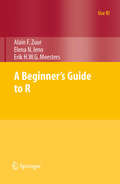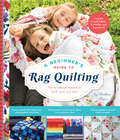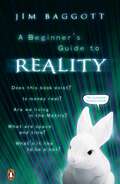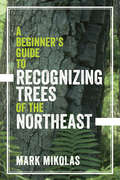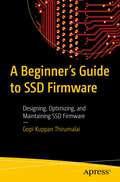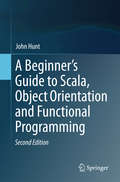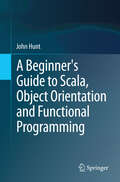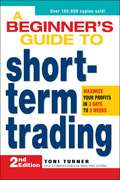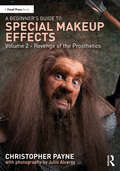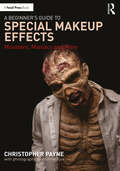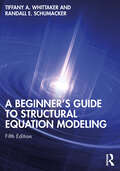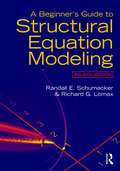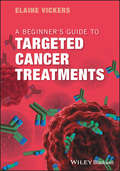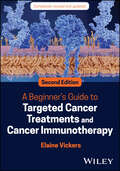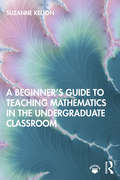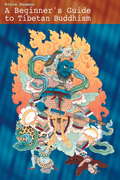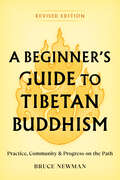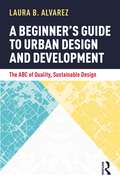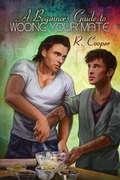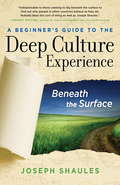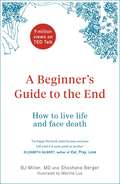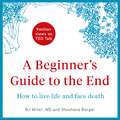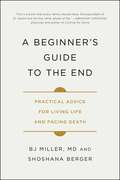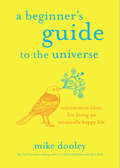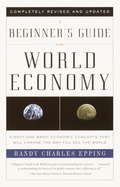- Table View
- List View
A Beginner's Guide to R: A Frequentist And Bayesian Perspective For Ecologists (Use R!)
by Elena N. Ieno Alain Zuur Erik MeestersBased on their extensive experience with teaching R and statistics to applied scientists, the authors provide a beginner's guide to R. To avoid the difficulty of teaching R and statistics at the same time, statistical methods are kept to a minimum. The text covers how to download and install R, import and manage data, elementary plotting, an introduction to functions, advanced plotting, and common beginner mistakes. This book contains everything you need to know to get started with R. "Its biggest advantage is that it aims only to teach R...It organizes R commands very efficiently, with much teaching guidance included. I would describe this book as being handy--it's the kind of book that you want to keep in your jacket pocket or backpack all the time, ready for use, like a Swiss Army knife." (Loveday Conquest, University of Washington) "Whilst several books focus on learning statistics in R..., the authors of this book fill a gap in the market by focusing on learning R whilst almost completely avoiding any statistical jargon...The fact that the authors have very extensive experience of teaching R to absolute beginners shines throughout." (Mark Mainwaring, Lancaster University) "Exactly what is needed...This is great, nice work. I love the ecological/biological examples; they will be an enormous help." (Andrew J. Tyne, University of Nebraska-Lincoln)
A Beginner's Guide to Rag Quilting
by Christine MannIn A Beginner's Guide to Rag Quilting, longtime quilter and bestselling author Christine Mann makes it easy to master the beginning principles of rag quilting with 12 easy starter projects. Packed with full-color photographs and tons of creative inspiration, every detail of the book from the step-by-step photographed instructions to the lay-flat spiral binding is designed specifically with the beginning quilter in mind.
A Beginner's Guide to Reality
by Jim BaggottA Beginner's Guide to Reality is an introduction to philosophy for people who don't read philosophy. Jim Baggott's sources range from Aristotle to The Matrix. He examines the major developments in Western philosophical thought on the nature of reality, at each of three levels - social, perceptual and physical. (Do money, colour, or photons exist?) The book systematically investigates these levels, peeling away the assumptions we make about those parts of reality that we take for granted.
A Beginner's Guide to Recognizing Trees of the Northeast
by Mark MikolasIdentify maple, ash, oak, and more with easy-to-learn visual techniques. In this friendly and approachable field guide, writer and avid hiker Mark Mikolas shares a unique approach for year-round tree identification. His method, which centers on the northeastern United States where 20 species make up the majority of trees, will prepare readers to recognize trees at a glance, even in winter when leaves and flowers are not present. Mikolas’s secret is to focus on the key characteristics of each tree—black cherry bark looks like burnt potato chips; beech and oak trees keep their leaves in winter; spruce needles are pointed while balsam fir needles are soft and rounded at the ends. Some trees can even be identified by scent. Location maps for each of the 40 species covered and more than 400 photographs illustrating key characteristics make the trees easy to identify. Mikolas also explains how to differentiate between similar and commonly confused trees, such as red maple and sugar maple. A Beginner’s Guide to Recognizing Trees of the Northeast is a book to keep close at hand wherever trees grow.
A Beginner's Guide to SSD Firmware: Designing, Optimizing, and Maintaining SSD Firmware
by Gopi Kuppan ThirumalaiExplore the concepts and techniques that are essential for designing, optimizing, and maintaining SSD (solid state drive) firmware. This book discusses the role of firmware in the functioning of SSDs and the importance of keeping firmware up to date to ensure optimal performance and security. The book starts with an introduction to SSD firmware and its role in SSDs. You will then learn basic NAND operations and common firmware features, followed by various design considerations and best practices for optimizing and maintaining SSD firmware. Moving ahead, you will learn some of the advanced features that are included in modern SSD firmware, such as wear leveling algorithms, garbage collection algorithms, error prevention and correction methods, and algorithms to reduce write amplification. User data flow and exception handling are discussed next, along with performance and debugging. To wrap things up, you will gain insight into possible future developments and innovations in SSD firmware. After reading this book, you will have a solid understanding of the key concepts and techniques that are crucial to designing, optimizing, and maintaining SSD firmware. What Will You Learn Understand the fundamentals of NAND flash memory, including its architecture, operation, and limitationsExplore the basics and evolution of firmware, specifically in the context of SSDsGrasp the basics of firmware, including its purpose, structure, and development processSurvey the specific features of SSD firmware, such as wear leveling, error correction, and garbage collectionUnderstand performance criteria for SSDsMaster the art of designing a fundamental SSD firmware, encompassing host interfaces and vital requirements Who Is This Book For: Engineers involved in designing and developing firmware.
A Beginner's Guide to Scala, Object Orientation and Functional Programming
by John HuntScala is now an established programming language developed by Martin Oderskey and his team at the EPFL. The name Scala is derived from Sca(lable) La(nguage). Scala is a multi-paradigm language, incorporating object oriented approaches with functional programming. Although some familiarity with standard computing concepts is assumed (such as the idea of compiling a program and executing this compiled from etc.) and with basic procedural language concepts (such as variables and allocation of values to these variables) the early chapters of the book do not assume any familiarity with object orientation nor with functional programming These chapters also step through other concepts with which the reader may not be familiar (such as list processing). From this background, the book provides a practical introduction to both object and functional approaches using Scala. These concepts are introduced through practical experience taking the reader beyond the level of the language syntax to the philosophy and practice of object oriented development and functional programming. Students and those actively involved in the software industry will find this comprehensive introduction to Scala invaluable.
A Beginner's Guide to Scala, Object Orientation and Functional Programming
by John HuntScala is a new programming language developed by Martin Odersky and his team at the EPFL. The name Scala is derived from Sca(lable) La(nguage). Scala is a multi-paradigm language, incorporating object oriented approaches with functional programming. Although some familiarity with standard computing concepts is assumed (such as the idea of compiling a program and executing this compiled form, etc.) and with basic procedural language concepts (such as variables and allocation of values to variables) the early chapters of the book do not assume any familiarity with object orientation nor functional programming. These chapters also step through other concepts with which the reader may not be familiar (such as list processing). From this background, John Hunt provides a practical introduction to object and functional technology using Scala, one of the newest and most interesting programming languages available. A variety of concepts are introduced through practical experience taking the reader beyond the level of the language syntax to the philosophy and practice of object-oriented development and functional programming. Students, and those actively involved in the software industry will find this comprehensive introduction to Scala and to object orientation and functional programming, invaluable.
A Beginner's Guide to Short-Term Trading: Maximize Your Profits in 3 Days to 3 Weeks
by Toni TurnerTrade you way to financial success!Are you tired of playing the "buy-and-hope" game with your stocks? Savvy stock trader Toni Turner shows you the ins and outs and ups and downs of short-term trading. You'll learn how to buy and sell stocks on a monthly, weekly, or even daily basis, so you can own the right stocks at the right time. Turner's clear, common-sense advice, easy-to-follow explanations, and helpful examples will help you invest in the exciting and profitable world of short-term trading quickly and safely. In this revised edition, you'll get completely up-to-date information on: -New products such as ETFs and expanded coverage on sector investing -Resources for choosing an online broker New SEC (Securities and Exchange Commission) rules and regulations -Updated charts and graphs with current examples A Beginner's Guide to Short-Term Trading is the hands-on book designed to get you actively involved in every step of the trading process. Now you can take control of your portfolio and secure the financial freedom you've always dreamed of. Start planning your trades today!
A Beginner's Guide to Special Makeup Effects, Volume 2: Revenge of the Prosthetics
by Christopher PayneA Beginner’s Guide to Special Makeup Effects, Volume 2 builds on the foundations covered in A Beginner's Guide to Special Makeup Effects: Monsters, Maniacs and More, introducing more professional-level materials and techniques and preparing readers for the next steps in their career.This book is divided into two sections: Paint and Buildups and Prosthetics. The first section shows a variety of characters created using two-dimensional painting techniques and materials that can be built up right on the skin, while the second section teaches how to apply a variety of store-bought prosthetics. Foam latex, silicone and prosthetic transfers are all covered. Each character is introduced with a full-page photograph of the finished makeup and illustrated with full-color, step-by-step photographs. The makeup tutorials in this book are designed to build on the lessons learned in the previous chapters, allowing readers to gradually expand on their skill set. The book also includes instruction on airbrushing, applying fake tattoos, making bald caps, PAX paint, wig application and a variety of other materials and skills. Five appendices cover topics including building a makeup kit, photographing your work and getting jobs as a makeup artist.This is practical, easy-to-follow makeup book is suited for students of stage makeup courses, as well as for the theatre technician working and training on their own.
A Beginner's Guide to Special Makeup Effects: Monsters, Maniacs and More
by Christopher PayneA Beginner's Guide to Special Makeup Effects: Monsters, Maniacs and More is an introduction to special effects makeup using cost-effective tools and materials that can be found in local stores. The book is divided into three sections – Simple Makeup, Advanced Materials and Techniques and Advanced Makeup – and features tutorials to create characters such as a pirate, vampire, ghost, robot, burn victim, witch, zombie and goblin. Each character is introduced with a full-page photograph of the finished makeup and illustrated with full-color, step-by-step photographs. The book also includes instructions on how to make fake teeth, apply bald caps, create gory wounds and injuries and make simple prosthetics. Each makeup tutorial is designed to progressively build on the techniques outlined in the preceding tutorial, guiding readers from the basics of foundation, highlight and shadow to creating advanced creature makeups. This is a beginner makeup book suited for students of Stage Makeup courses, as well as for the theatre technician working and training on their own.
A Beginner's Guide to Structural Equation Modeling
by Tiffany A. Whittaker Randall E. SchumackerA Beginner’s Guide to Structural Equation Modeling, fifth edition, has been redesigned with consideration of a true beginner in structural equation modeling (SEM) in mind. The book covers introductory through intermediate topics in SEM in more detail than in any previous edition. All of the chapters that introduce models in SEM have been expanded to include easy-to-follow, step-by-step guidelines that readers can use when conducting their own SEM analyses. These chapters also include examples of tables to include in results sections that readers may use as templates when writing up the findings from their SEM analyses. The models that are illustrated in the text will allow SEM beginners to conduct, interpret, and write up analyses for observed variable path models to full structural models, up to testing higher order models as well as multiple group modeling techniques. Updated information about methodological research in relevant areas will help students and researchers be more informed readers of SEM research. The checklist of SEM considerations when conducting and reporting SEM analyses is a collective set of requirements that will help improve the rigor of SEM analyses. This book is intended for true beginners in SEM and is designed for introductory graduate courses in SEM taught in psychology, education, business, and the social and healthcare sciences. This book also appeals to researchers and faculty in various disciplines. Prerequisites include correlation and regression methods.
A Beginner's Guide to Structural Equation Modeling: Fourth Edition
by Richard G. Lomax Randall E. SchumackerNoted for its crystal clear explanations, this book is considered the most comprehensive introductory text to structural equation modeling (SEM). Noted for its thorough review of basic concepts and a wide variety of models, this book better prepares readers to apply SEM to a variety of research questions. Programming details and the use of algebra are kept to a minimum to help readers easily grasp the concepts so they can conduct their own analysis and critique related research. Featuring a greater emphasis on statistical power and model validation than other texts, each chapter features key concepts, examples from various disciplines, tables and figures, a summary, and exercises. Highlights of the extensively revised 4th edition include: -Uses different SEM software (not just Lisrel) including Amos, EQS, LISREL, Mplus, and R to demonstrate applications. -Detailed introduction to the statistical methods related to SEM including correlation, regression, and factor analysis to maximize understanding (Chs. 1 - 6). -The 5 step approach to modeling data (specification, identification, estimation, testing, and modification) is now covered in more detail and prior to the modeling chapters to provide a more coherent view of how to create models and interpret results (ch. 7). -More discussion of hypothesis testing, power, sampling, effect sizes, and model fit, critical topics for beginning modelers (ch. 7). - Each model chapter now focuses on one technique to enhance understanding by providing more description, assumptions, and interpretation of results, and an exercise related to analysis and output (Chs. 8 -15). -The use of SPSS AMOS diagrams to describe the theoretical models. -The key features of each of the software packages (Ch. 1). -Guidelines for reporting SEM research (Ch. 16). -www.routledge.com/9781138811935 which provides access to data sets that can be used with any program, links to other SEM examples, related readings, and journal articles, and more. Reorganized, the new edition begins with a more detailed introduction to SEM including the various software packages available, followed by chapters on data entry and editing, and correlation which is critical to understanding how missing data, non-normality, measurement, and restriction of range in scores affects SEM analysis. Multiple regression, path, and factor models are then reviewed and exploratory and confirmatory factor analysis is introduced. These chapters demonstrate how observed variables share variance in defining a latent variables and introduce how measurement error can be removed from observed variables. Chapter 7 details the 5 SEM modeling steps including model specification, identification, estimation, testing, and modification along with a discussion of hypothesis testing and the related issues of power, and sample and effect sizes.Chapters 8 to 15 provide comprehensive introductions to different SEM models including Multiple Group, Second-Order CFA, Dynamic Factor, Multiple-Indicator Multiple-Cause, Mixed Variable and Mixture, Multi-Level, Latent Growth, and SEM Interaction Models. Each of the 5 SEM modeling steps is explained for each model along with an application. Chapter exercises provide practice with and enhance understanding of the analysis of each model. The book concludes with a review of SEM guidelines for reporting research. Designed for introductory graduate courses in structural equation modeling, factor analysis, advanced, multivariate, or applied statistics, quantitative techniques, or statistics II taught in psychology, education, business, and the social and healthcare sciences, this practical book also appeals to researchers in these disciplines. Prerequisites include an introduction to intermediate statistics that covers correlation and regression principles.
A Beginner's Guide to Targeted Cancer Treatments
by Elaine VickersThe accessible guide to the principles behind new, more targeted drug treatments for cancer Written for anyone who encounters cancer patients, cancer data or cancer terminology, but have no more than a passing knowledge of cell biology. A Beginner's Guide to Targeted Cancer Treatments provides an understanding of how cancer works and the many new treatments available. Using over 100 original illustrations, this accessible handbook covers the biology and mechanisms behind a huge range of targeted drug treatments, including many new immunotherapies. Dr Vickers translates a complex and often overwhelming topic into something digestible and easily understood. She also explains what cancer is, how it behaves and how our understanding of cancer has changed in recent years. Each chapter takes the reader through how new cancer drugs work and their benefits and limitations. With the help of this book, readers will be able to better understand more complex, in-depth articles in journals and books and develop their knowledge. This vital resource: Offers the latest insights into cancer biology Provides a broad understanding of how targeted cancer treatments work Describes many of the new immunotherapy approaches to cancer treatment, such as checkpoint inhibitors and CAR-modified T cells Helps readers feel confident discussing treatment options with colleagues and patients Provides an overview of which treatments are relevant to each of the most common solid tumours and haematological cancers, and the rationale behind them Demystifies the jargon – terms such as the EMT, cancer stem cells, monoclonal antibodies, kinase inhibitors, angiogenesis inhibitors etc. Explains the resistance mechanisms to many new treatments, including issues such as the way cancer cells diversify and evolve and the complex environment in which they live
A Beginner's Guide to Targeted Cancer Treatments and Cancer Immunotherapy
by Elaine VickersDemystifying the science behind new cancer treatments A clear and accessible guide written in everyday language for nurses and other healthcare professionals A Beginner’s Guide to Targeted Cancer Treatments and Cancer Immunotherapy helps readers understand the science behind many of the newer drug treatments for cancer. Assuming only a basic familiarity with cell biology, this easy-to-digest guide describes how our increased understanding of cancer has been translated into the creation of new cancer treatments with a wide range of targets. Gifted communicator and educator Dr. Elaine Vickers helps you understand the mechanisms of a wide range of individual targeted therapies and immunotherapies — enabling you to communicate effectively with your colleagues and patients. Concise chapters explain how new cancer drugs and immunotherapies work, discuss their benefits, identify their limitations, and more. Now in its second edition, this popular handbook is fully revised to reflect the latest developments in targeted drug therapies and immunotherapies. Entirely new chapters on advancements in various immunotherapies are accompanied by more than 100 new and updated color illustrations. Provides an up-to-date overview of relevant treatment targets for all major cancer types, including hematological cancersDescribes cancer biology and the relationship between cancer and the immune systemOffers valuable insights into cell communication pathways as a common targetCovers small molecule drugs, antibody-based treatments, and cellular therapies, including novel immunotherapies A Beginner’s Guide to Targeted Cancer Treatments and Cancer Immunotherapy is a must-have resource for trainees, practicing nurses, and other healthcare professionals involved in the care of cancer patients, as well as non-specialists who encounter cancer data or cancer terminology in their field.
A Beginner's Guide to Teaching Mathematics in the Undergraduate Classroom
by Suzanne KeltonThis practical, engaging book explores the fundamentals of pedagogy and the unique challenges of teaching undergraduate mathematics not commonly addressed in most education literature. Professor and mathematician, Suzanne Kelton offers a straightforward framework for new faculty and graduate students to establish their individual preferences for course policy and content exposition, while alerting them to potential pitfalls. The book discusses the running of day-to-day class meetings and offers specific strategies to improve learning and retention, as well as concrete examples and effective tools for class discussion that draw from a variety of commonly taught undergraduate mathematics courses. Kelton also offers readers a structured approach to evaluating and honing their own teaching skills, as well as utilizing peer and student evaluations. Offering an engaging and clearly written approach designed specifically for mathematicians, A Beginner’s Guide to Teaching Mathematics in the Undergraduate Classroom offers an artful introduction to teaching undergraduate mathematics in universities and community colleges. This text will be useful for new instructors, faculty, and graduate teaching assistants alike.
A Beginner's Guide to Tibetan Buddhism
by Bruce Newman"This is a ground-level, practice-oriented presentation of Tibetan Buddhism--personal and very accessible. The book begins with the awakening of students' interest in spirituality and the initial encounter with Tibetan Buddhism, then leads us through all the steps necessary for successful practice in the West. Included is succinct counsel on finding an appropriate teacher, receiving empowerments, becoming active in a center, and launching and sustaining a Vajrayana practice. Special emphasis is placed on the potential pitfalls, and the marvelous benefits, of the guru-disciple relationship. "
A Beginner's Guide to Tibetan Buddhism: Practice, Community, and Progress on the Path
by Bruce NewmanUncover the nature of the mind with this ground-level, practice-oriented presentation of Tibetan Buddhism. A personal and accessible guide to establishing progress on the path.The book begins with the awakening of students' interest in spirituality and the initial encounter with Tibetan Buddhism, then leads us through all the steps necessary for successful practice in the West. Included is succinct counsel on finding an appropriate teacher, receiving empowerments, becoming active in a center, and launching and sustaining a Vajrayana practice. Special emphasis is placed on the potential pitfalls, and the marvelous benefits, of the guru-disciple relationship.
A Beginner's Guide to Urban Design and Development: The ABC of Quality, Sustainable Design
by Laura B. AlvarezThis book provides invaluable guidance to all those with an interest in placemaking and the built environment, from those with no experience to those who have worked for many years in industry, illustrating key principles that will secure higher quality, more sustainable design in accessible, jargon-free language. The author explains the design process in a straightforward way, exploring the different roles and highlighting the opportunities and limitations different agencies have to influence design over the various stages of the process. Examples from the UK and worldwide look at how the system operates and how best practice can make a real difference on the ground. Case studies examine situations where quality or sustainability fell short – and how this could have been avoided. This book also showcases a variety of evaluation tools, explaining how they operate, and giving guidance on how to create project-specific tools to drive schemes forward. With community empowerment at its core, the book explains technical language and shares bountiful knowledge to broaden place democracy and make influencing design accessible to many, not just a few. This is a book that brings together all the various parties involved in shaping the built environment, demonstrating that collaboration and mutual understanding are key to achieving better quality, more sustainable design.
A Beginner's Guide to Wooing Your Mate (Being(s) in Love #3)
by R. CooperA Being(s) in Love StoryZeki Janowitz has returned to his hometown of Wolf's Paw to start his wizarding career. Unfortunately, Wolf's Paw, a werewolf refuge, follows centuries of tradition and shuns human magic and a very human Zeki. He knows he's in for a struggle, but a part of him has always belonged in the mountain town, or rather belonged to Theo Greenleaf. Years away at school haven't lessened Zeki's crush on the quiet werewolf. When town gossip informs him Theo still suffers from his mate's rejection and does not date, it does little to ease Zeki's embarrassing feelings. He decides now's the time to get the man he's always wanted. Werewolves usually don't recover from losing their mates, and Theo barely pulled through by focusing on his love of baking. It's a daily struggle, and Zeki's return to Wolf's Paw shatters his peace. Theo doesn't know what to think when Zeki attempts to woo him, talking about his wizarding business and settling in town for good. It's like Zeki doesn't have a clue how his words years before left Theo a shell of a werewolf. Beginners in love, Theo and Zeki must seduce each other with a bit of heavenly baking and magic.
A Beginner's Guide to the Deep Culture Experience: Beneath the Surface
by Joseph ShaulesWhen we leave and travel abroad, for pleasure or for business, we make a choice: to have a superficial “airport experience” at our destination, or to appreciate the hidden culture beneath the surface. A Beginner’s Guide to the Deep Culture Experience proposes a deep culture journey, encouraging travelers to pursue a meaningful cross-cultural experience. Sharing anthropologist Edward Hall’s conviction that becoming aware of our unconscious cultural programming is a transcendental challenge facing us all, author Joseph Shaules shows how the “deep culture experience” can teach us about ourselves. This practical book is an accessible introduction to intercultural communication without buzz words, theory or abstraction. If you travel internationally for work or simply enjoy the diverse cultures of the world, read this inspirational book before your next trip.
A Beginner's Guide to the End: How to Live Life to the Full and Die a Good Death
by Shoshana Berger BJ Miller"I wish I'd had this book when I needed it. Death and dying are not subjects that many people are comfortable talking about, but it's hugely important to be as prepared as you can be - emotionally, physically, practically, financially, and spiritually. This book may be the most important guide you could have." - Elizabeth Gilbert, author of Eat Pray Love ___________The end of a life can often feel like a traumatic, chaotic and inhuman experience. In this reassuring and inspiring book, palliative care physician Dr BJ Miller and writer Shoshana Berger provide a vision for rethinking and navigating this universal process. There are plenty of self-help books for mourners, but nothing in the way of a modern, approachable and above all useful field guide for the living. And all of us - young, old, sick and well - could use the help. After all, pregnant couples have ample resources available to them as they prepare to bring a new life into the world: Lamaze courses, elaborate birth plans, tons of manuals. Why don't we have a What to Expect When You're Expecting to Die book?An accessible, beautifully designed and illustrated companion, A Beginner's Guide to the End offers a clear-eyed and compassionate survey of the most pressing issues that come up when one is dying, and will bring optimism and practical guidance to empower readers with the knowledge, resources and tools they'll need to die better, maybe even with triumph.
A Beginner's Guide to the End: How to Live Life to the Full and Die a Good Death
by Shoshana Berger BJ Miller"I wish I'd had this book when I needed it. Death and dying are not subjects that many people are comfortable talking about, but it's hugely important to be as prepared as you can be - emotionally, physically, practically, financially, and spiritually. This book may be the most important guide you could have." - Elizabeth Gilbert, author of Eat Pray Love ___________The end of a life can often feel like a traumatic, chaotic and inhuman experience. In this reassuring and inspiring book, palliative care physician Dr BJ Miller and writer Shoshana Berger provide a vision for rethinking and navigating this universal process. There are plenty of self-help books for mourners, but nothing in the way of a modern, approachable and above all useful field guide for the living. And all of us - young, old, sick and well - could use the help. After all, pregnant couples have ample resources available to them as they prepare to bring a new life into the world: Lamaze courses, elaborate birth plans, tons of manuals. Why don't we have a What to Expect When You're Expecting to Die book?An accessible, beautifully designed and illustrated companion, A Beginner's Guide to the End offers a clear-eyed and compassionate survey of the most pressing issues that come up when one is dying, and will bring optimism and practical guidance to empower readers with the knowledge, resources and tools they'll need to die better, maybe even with triumph. (P) 2019 Simon & Schuster
A Beginner's Guide to the End: Practical Advice for Living Life and Facing Death
by Dr. BJ Miller Shoshana Berger&“A gentle, knowledgeable guide to a fate we all share&” (The Washington Post): the first and only all-encompassing action plan for the end of life.&“There is nothing wrong with you for dying,&” hospice physician B.J. Miller and journalist and caregiver Shoshana Berger write in A Beginner&’s Guide to the End. &“Our ultimate purpose here isn&’t so much to help you die as it is to free up as much life as possible until you do.&” Theirs is a clear-eyed and big-hearted action plan for approaching the end of life, written to help readers feel more in control of an experience that so often seems anything but controllable. Their book offers everything from step-by-step instructions for how to do your paperwork and navigate the healthcare system to answers to questions you might be afraid to ask your doctor, like whether or not sex is still okay when you&’re sick. Get advice for how to break the news to your employer, whether to share old secrets with your family, how to face friends who might not be as empathetic as you&’d hoped, and how to talk to your children about your will. (Don&’t worry: if anyone gets snippy, it&’ll likely be their spouses, not them.) There are also lessons for survivors, like how to shut down a loved one&’s social media accounts, clean out the house, and write a great eulogy. An honest, surprising, and detail-oriented guide to the most universal of all experiences, A Beginner&’s Guide to the End is &“a book that every family should have, the equivalent of Dr. Spock but for this other phase of life&” (New York Times bestselling author Dr. Abraham Verghese).
A Beginner's Guide to the Universe: Uncommon Ideas for Living an Unusually Happy Life
by Mike DooleyMike Dooley, the beloved creator of Notes from the Universe, distills a career's worth of inspiration into elegant, brief lessons for making our way through the world--conceived as a guidebook for his young daughter to read when she grows up, yet relevant to everyone who's living a life on earth.Mike returns with his most impactful book yet: a volume of almost 500 insights drawn from his 20+ years as a New Thought leader, organized between endearing letters that recall poignant moments of fatherhood.Through books, courses, and live events, Mike has engaged students with his trademark humor, wisdom, and sheer joy in living. He speaks of understanding our innate spirituality and personal responsibility as the means to unlocking our power over the illusions of time and space. A Beginner's Guide to the Universe is filled with gem-like bits of wisdom imparting his most essential, heartfelt advice about living deliberately and creating consciously--comparable to such treasures as Life's Little Instruction Book, The Prophet, and The Things You Can See Only When You Slow Down. Cleverly guiding the reader through a range of topics--including family and relationships, power and responsibility, adversity and rebounding, even the nature of heaven, angels, and God--Mike succeeds in making a happy life in this universe seem easily within our reach. The short passages of text placed artfully on each page, in a book that's a pleasure to hold in the hand, make this an ideal gift for a parent, a parent-to-be, a child, a new grad, a dear friend, or anyone who needs a dose of Dooley, whether they know it or not.
A Beginner's Guide to the World Economy
by Randy Charles EppingThe third edition updates the information in previous editions and explains many new concepts. What is the new economy? What is globalization? Is the euro the final seal on European Union? How is e-commerce transforming our world beyond economics? What is virtual money, and does it have real value? How do social concerns and societal ills (drugs, poverty, AIDS, endangered natural resources) play a part in the rapidly changing world economy. What are multinationals, and do they signal the end of nationalism? These and many other pertinent issues are concisely addressed in the most accessible primer for those who want to be economically literate (and who doesn't?).
